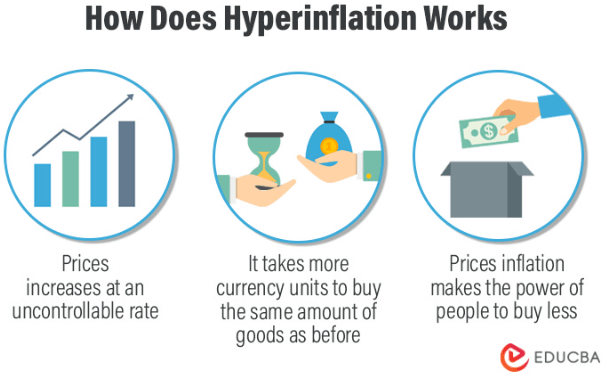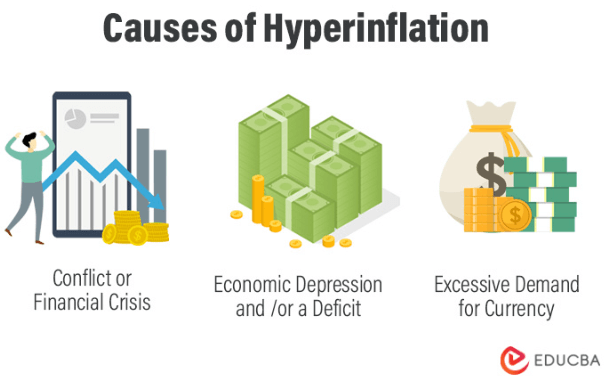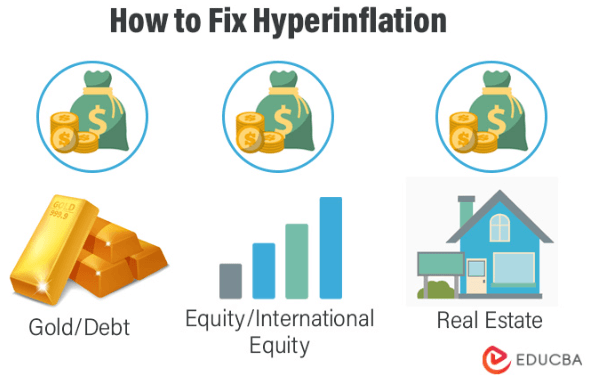Updated July 4, 2023
Hyperinflation Meaning
Hyperinflation is a type of inflation that involves a rapid increase in prices over a short period. As the costs of all things rise, a currency’s actual value quickly depreciates. It prompts people to reduce their currency holdings and typically shifts to more stable options, i.e., foreign currencies.
Key Highlights
- Hyperinflation is a rise in the general price level of goods and services to an arbitrarily high level. It will result in shortages of certain goods and severe inflation rates.
- There are different degrees of hypersensitivity: mild, moderate, and high. A country can have low or high inflation rates, but if prices are constantly rising, it becomes hard for people to keep up with the price changes.
- The consumer price index (CPI) measures this by comparing what things cost now versus what they would have cost at some point, usually one year ago.
- Prices go up because too much money gets printed or because people want more money than there is and will pay anything for it.
What is Hyperinflation?
- Hyperinflation occurs when a nation experiences abrupt price increases for goods over a brief period because of excessive money printing, followed by sharp drops in demand.
- It happens when a country’s currency rapidly devalues, and the resultant increase in the price level spirals out of control. When this occurs, there are often other negative consequences. For example, more people use bartering instead of money because it’s more practical.
- With hyperinflation, companies stop working since their products become unaffordable for consumers. Banks also stop lending because they know the loan repayments will happen with an inflated currency that has no value.
Features of Hyperinflation
- It is a challenging economic environment
- The prices of goods and services rise excessively and quickly as a result
- The local currency’s face value declines
- Negatively affects the economy and destabilizes it
- It follows a long period of high and consistent inflation.
How Does Hyperinflation Work?
- Prices increase uncontrollably because of the circulation of insufficient currency to keep up with demand. Prices rise to fill the gap between inflation and economic growth.
- More importantly, buying the same goods as before takes more and more currency units.
- As prices inflate, people have less spending power, which leads them to withdraw their cash from banks and hoard it at home or invest it in tangible assets like gold or collectibles, driving up prices for those things too.
- Governments often try to stop this cycle by imposing capital controls, but that usually doesn’t work.
- When hyperinflation has run its course and prices stabilize again, one US dollar might be worth one hundred trillion Zimbabwean dollars.
Real-World – Examples
Here are some historical instances of hyperinflation:
- Argentina has experienced several instances of hyperinflation. In 1989, there was 4923.3% annual inflation, also known as hyperinflation.
- Germany experienced hyperinflation after losing the First World War. There were 64 marks to the dollar in January 1921. It had changed to 4,200,000,000,000 marks to the dollar by November 1923.
- Venezuela: Venezuela experienced hyperinflation in 2015, as measured by inflation of more than 9000% annually. According to Bloomberg data, hyperinflation in Venezuela has been accelerating since late 2015. It is now one of the most rapidly deteriorating economies on Earth. On July 31, 2018, Venezuela’s annual inflation rate hit an estimated 1,369%.
- Zimbabwe: In 2008, Zimbabwe was reportedly suffering hyperinflation, reaching a rate of 89.7 sextillion percent. That’s 89, followed by 21 zeros- an astronomical number even when expressed as a decimal.
- Yugoslavia: Yugoslavia experienced hyperinflation in 1994, peaking at 313 million percent per month. Money was virtually worthless, and barter became a way of life. The government issued coupons that people could use to buy food; however, there were not enough coupons for everyone. The citizens began using foreign or local currencies from other countries instead of their own because it was more stable.
Causes of Hyperinflation
The causes of hyperinflation are generally complex and constantly discussed because they can vary greatly depending on the economy under study and the context of the economic crisis.
Following is a list of the primary causes of hyperinflation:
- A highly charged political environment like a conflict or financial crisis.
- The most significant cause is a massive influx of foreign currency or, even worse, a complete devaluation of the local currency. This kind of cause primarily happens because of war. However, some economic depression and a deficit in the social or economic part of the nation may also cause it.
Effects of Hyperinflation
Hyperinflation has the following main effects:
- There is high unemployment.
- A barter economy may start in the country because of severe hyperinflation.
- Because it is a massive economic situation, not even the economic authorities can influence it.
- The financial system may get destabilized because banks become reluctant to give loans.
- Tax revenues may also decrease if customers and companies cannot pay their taxes. It would prevent governments from offering necessary services.
- It causes population impoverishment in general.
- Hyperinflation promotes the reduction of social class’s purchasing power.
How to Fix Hyperinflation?
- As the government loses its credibility, it often turns to inflation to compensate for any economic shortfall. When this happens, we enter into a period of hyperinflation, and the currency becomes effectively worthless as prices skyrocket. The only way out of hyperinflation is through an increase in consumer demand, a drop in investment, or an expansion in supply-side capacity. Responsible fiscal policy and sensible interest rates can fix this.
- Generally speaking, the best way to combat inflation is with brute force, that is, in the most categorical manner possible. Governments can achieve this through shock therapy as the first factor in reducing public expenditures that may affect the currency’s fundamentals.
- For instance, Bosnia-Herzegovina did this in 2015 when it placed the country under monetary supervision, limiting the amount of foreign currency that can get printed by the central bank.
- Another example is Ecuador, which switched to the dollar as its official currency almost immediately after the turn of the millennium, or in the year 2000, following a devaluation of 75% of the sucre at the beginning of that year.
- As a result, either implementing a foreign currency or creating a new currency could end hyperinflation.
- Using a more stable foreign currency than the one you were using before is one potential solution or method of defense.
- Particular currency exchange uses the indexing method because even foreign currency complies with the same inflation present where it gets handled, i.e., in the exact location.
Advantages
One of the hyperinflation’s primary positive impacts is on business.
In periods of hyperinflation, prices for goods tend to rise rapidly. Products generally considered luxury items might become available at affordable rates.
For example, a high-end laptop that costs $3,000 may get sold for as little as $300. These low prices help businesses grow fast and provide consumers with more options than they had previously. It may also result in low manufacturing costs while companies are still making a profit.
Disadvantages
The most extreme form of hyperinflation can destroy an economy; with extremely high levels, individuals will prefer to use foreign currencies or gold as a store of value. If people lose faith in their country’s economic and political stability, they might also convert their assets into another currency, which could trigger more chaos.
Economists have identified four major disadvantages of hyperinflation:
- Debt becomes unpayable;
- Investment returns diminish because prices keep going up;
- Social unrest increases due to inequality between rich and poor;
- Countries might resort to printing money without limit, which only exacerbates the problem.
FAQs
1. What are the consequences of hyperinflation?
Answer: The main effects of hyperinflation include a sharp decline in the population’s purchasing power, a disincentive to save and invest in the country’s currency, and a capital flight that results from a severe economic downturn.
2. What is the difference between inflation and hyperinflation?
Answer: A phenomenon known as inflation causes aggregate prices to rise steadily and has an impact on the economy. Significantly higher inflation rates are the cause of hyperinflation.
3. In times of hyperinflation, what happens to the debt?
Answer: For example, if an individual has a car loan at 10% interest and their country’s currency experiences hyperinflation, there may be very little to do. The person may try to find ways to reduce expenses or increase income—but they will likely not want to give up their car. Thus, once there is a contract for the debt, the borrower has to repay it.
4. What happens to real estate when there is hyperinflation?
Answer: Unsurprisingly, when there is hyperinflation, people will try to get their money out of a country. Usually, people try to sell real estate or property to convert their cash into some wealth that has value (like gold or silver). It often means that real estate prices drop as many investors try to sell at once. But more importantly, hyperinflated countries will likely be impossible for people living there.
5. What is the inflation rate?
Answer: Inflation refers to a general increase in prices and a fall in the value of a currency over time. While everyone experiences inflation at different rates based on where they live and their unique circumstances, it generally costs between 3-5% per year for most people. In layman’s terms, there is excess money chasing too few goods.
Recommended Articles
This article explains everything about hyperinflation. To learn more about hyperinflation, visit the following links:





